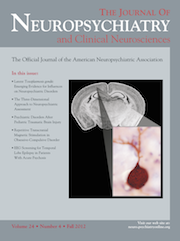Late-Onset Bipolar Disorder and Cognitive Impairment: A Case Report
To the Editor: New-onset mania in elderly persons is more than twofold more likely to have comorbid neurological disorders such as silent cerebral infarcts, tumors, neurosyphilis, and frontotemporal dementia (FTD) than in younger patients.1 The literature reveals the extent and course of cognitive deficits among patients with bipolar disorder (BD).2 The case reported here arose from clinical observations of an elderly adult patient with psychotic BD.
Case Report
“Mr. G” was born in 1950, is retired, married, and the father of a child. He and his family have described several hypomanic episodes each spring since 1996, with irritability, anger, and increase in the amount of speech, excessive, running thoughts, grandiosity and feeling fearless. Sodium valproate + valproic acid 1,000 mg/day was initiated in one of such episodes. Also, they have described depressive episodes occurring each winter since 1996. However, in 2003, Mr. G started to suffer from auditory and visual hallucinations. Meanwhile, the patient started to have sensory aphasia and difficulty in executive functions such as ordering, planning, and abstracting. The family informed us that the hypomanic and depressive episodes have disappeared since 2005. In his laboratory assessment, serum folate, vitamin B12, and thyroid hormone levels were in normal ranges, and HIV and syphilis markers were negative. Cranial MRI showed cerebellar and cerebral atrophy; PET scan revealed significant hypometabolism in bilateral parietotemporal regions. Neuropsychological assessment showed inability to maintain attention, frontal-type deterioration in verbal memory, impairment in visual-spatial configuration, language and speech apraxia, and difficulty in making and repeating sentences was noted. According to these findings frontotemporal-type dementia was diagnosed, and rivastigmine 16 mg/day was added by titration.
Discussion
At the beginning, we diagnosed the present case as bipolar affective disorder because of the episodic course of depressive and manic symptoms. However, the addition of some core features of FTD,1 such as hallucinations, behavioral disturbances, sensory aphasia, apathy, indifference, and impairment in executive functions in a nonepisodic manner, have led us to diagnose the case as FTD. In a recent meta-analysis, psychotic BD patients were found to be associated with poorer cognitive performance, including verbal memory, executive function tests of planning/reasoning, and processing speed, than BD patients without a psychotic history.3 This case presentation might be remarkably important according to the recent discussion of relationship between BD and cognition in the literature.
1 : Frontotemporal dementia and mania. Am J Psychiatry 2007; 164:1811–1816Crossref, Medline, Google Scholar
2 : Neurocognitive dysfunction and psychosocial outcome in patients with bipolar I disorder at 15-year follow-up. Acta Psychiatr Scand 2010; 122:499–506Crossref, Medline, Google Scholar
3 : Neurocognitive markers of psychosis in bipolar disorder: a meta-analytic study. J Affect Disord 2010; 127:1–9Crossref, Medline, Google Scholar



